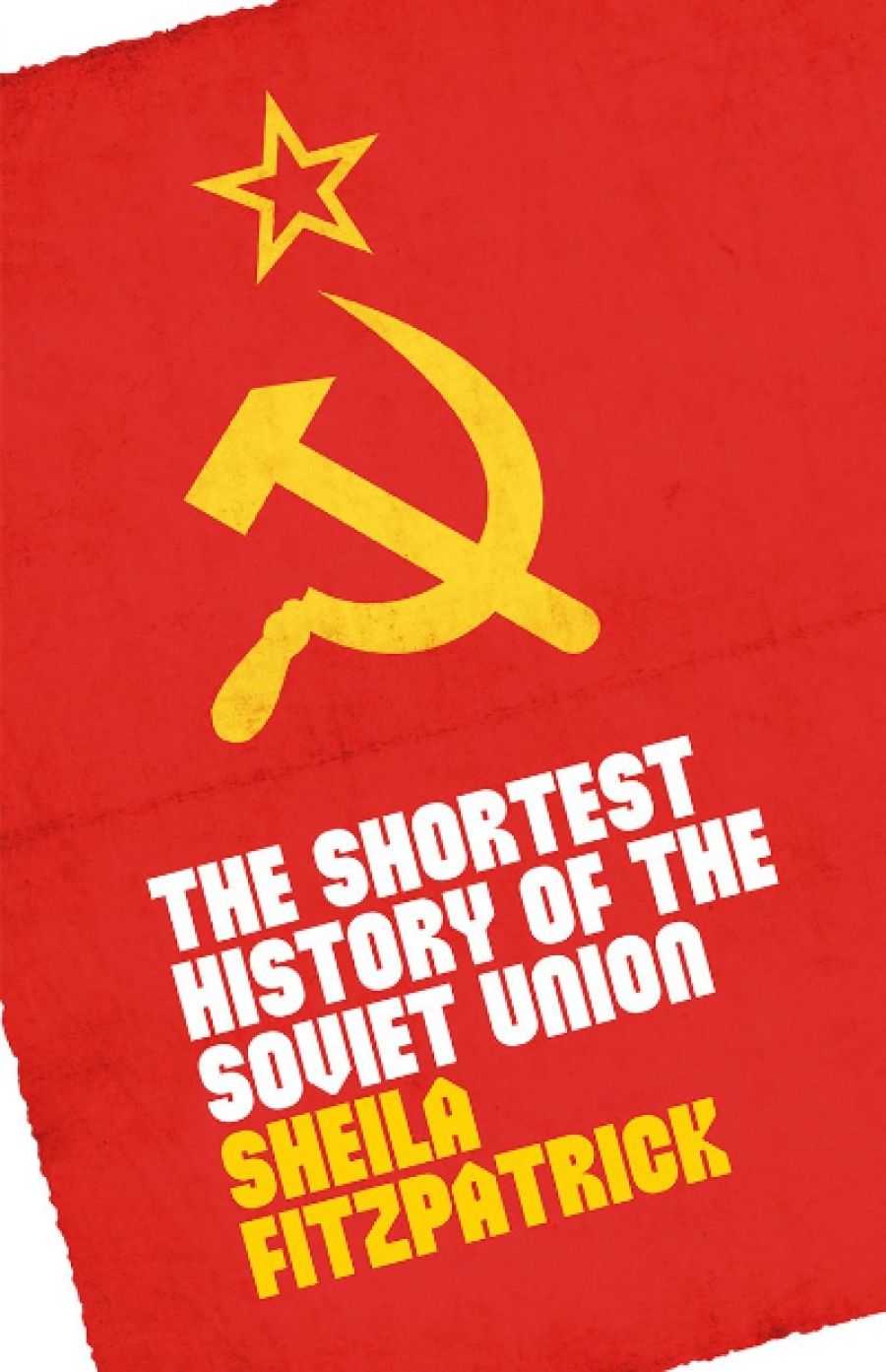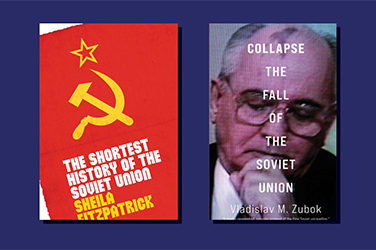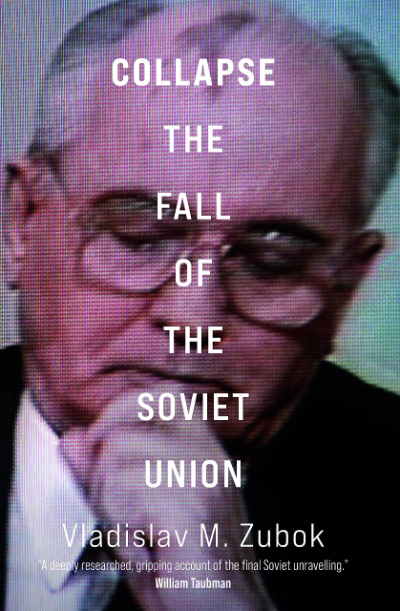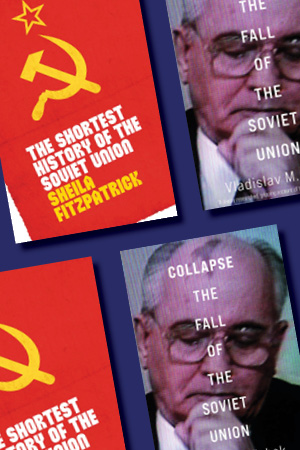
- Free Article: No
- Contents Category: Russia
- Review Article: Yes
- Article Title: Too little, too late
- Article Subtitle: From Bolshevism to gangster capitalism
- Online Only: No
- Custom Highlight Text:
In these relentless times, thirty years ago might be prehistory; events now appear to move so breathlessly that the ‘world-changing’ and ‘historic’ occur with terrible regularity. The flip side of this relentlessness and hyperbole is that wars, floods, financial disasters, coups, and political murders are just as quickly forgotten. As we enter a global recession brought on by the twin pincers of the Russian invasion of Ukraine and the lingering Covid-19 pandemic, it is easy to forget two other events still shaping our world: the global financial crisis of fifteen years ago, never fully overcome, and the 2001 attacks on the World Trade Center and the Pentagon.
- Featured Image (400px * 250px):

- Alt Tag (Featured Image): Luke Stegemann reviews 'The Shortest History of the Soviet Union' by Sheila Fitzpatrick and 'Collapse: The fall of the Soviet Union' by Vladislav M. Zubok
- Book 1 Title: The Shortest History of the Soviet Union
- Book 1 Biblio: Black Inc., $24.99 pb, 248 pp
- Book 1 Readings Link: booktopia.kh4ffx.net/jWLv1P
- Book 2 Title: Collapse
- Book 2 Subtitle: The fall of the Soviet Union
- Book 2 Biblio: Yale University Press, US$35 hb, 559 pp
- Book 2 Cover Small (400 x 600):

- Book 2 Cover (800 x 1200):

- Book 2 Cover Path (no longer required): images/ABR_Digitising_2022/Sep_2022/Collapse Vladislav Zubok.jpg
- Book 2 Readings Link: booktopia.kh4ffx.net/P0DPae
Dostoevsky had warned as far back as 1871, in The Devils, of the intimate connection between political utopianism and despotism. The Russian Revolution of 1917, emerging from the messy and tragic geopolitics of World War I, was mother to the brutal state that was the Soviet Union; in hindsight, its eventual collapse seems more probable than its birth. For the Russian Revolution might easily not have happened; it was a time when the paths open for European political futures were multiple, unstable, and highly contested. And when the revolution did happen, it might not have been Lenin’s Bolshevik faction that gained the upper hand. On the back of a world war, a global pandemic, a civil war, and constant internecine political struggles, the Bolsheviks set the tone for the rest of their regime: ruthless, addicted to power, uncompromisingly violent, stubbornly convinced of their own ‘historic mission’ to build a new society, and thus, like most utopians, murderous for those who stood in their way. It soon became obvious that this had nothing to do with ‘the proletariat’ and everything to do with power and control.
In the broader sweep of Russian and Soviet history, the line of autocratic misfits that were the Romanovs is later mirrored by an equally eccentric and dangerous series of communist rulers: the vile Lenin, the tyrant Stalin, the wily Khrushchev (clever enough to have his rival Beria shot), the morose and turgid Brezhnev. At last, in 1985, Mikhail Gorbachev emerged as a sane and capable technocrat, only to fail spectacularly. Gorbachev was followed by the clown Boris Yeltsin and the sinister figure of Vladimir Putin. Barely have the Russian people (or those other nationalities of the broader Eurasian empire) had any say in the election of this largely malignant cast that has served up the corruption and misgovernment that have plagued them from tsarist times.
In her compact history, Sheila Fitzpatrick shows how the Soviet Union, with its structural inequalities, privileged élites, hopeless economic management, suspicion of democracy and pluralism, and even deeper suspicion of intellectuals – not to mention everyday racism – was barely much of an advance on the old tsarist system. For all its industrialisation and talk of world revolution, the Soviet Union was often characterised by a deeply provincialist isolationism, fed by paranoid fears of the ‘capitalist’ other. ‘Aggressive cultural insularity’ is Fitzpatrick’s term, a combination of ‘boastfulness and inferiority’. Its brutality softened from the 1960s to the 1980s as world prosperity grew, but the Soviet Union was trapped in cumbersome centralised planning and single-party government, unable to grasp the opportunities offered by increasing democratisation and rapidly developing new technologies.
Fitzpatrick’s work is an admirable compression into 200 pages of seventy years thick with intrigue, war, murder, and geopolitics. It is an easy and engaging read from a historian who has dedicated her life to the field. Less clear is the intended audience for this book. In a time-poor world, there is a market for condensed histories – who now would dare read Gibbon? – but surely those fascinated by Russia and the Soviet Union gravitate towards the tomes as large as the country itself? Never mind Tolstoy, Grossman, or Solzhenitsyn; one only need recall recent epics such as The House of Government by Yuri Slezkine (a former student of Fitzpatrick’s) or Secondhand Time by Svetlana Alexievich to understand the appeal of the marathon read for those wishing to interpret this extraordinary continent, its history, and its people.
Vladislav Zubok is a case in point. Collapse is a long, unsparing, and meticulous account of the last days of the Soviet Union. The author is damning in his criticism of Gorbachev, so much a darling of the West, for his timid leadership and economic mismanagement of a disintegrating empire. His key policies of openness, or glasnost, and structural reforms, known as perestroika (buzzwords of the 1980s) promised everything but delivered too little and too late. Zubok builds his narrative around two broad themes: the economic stagnation of the late Soviet years, which added further frustration to a society both exhausted and desperate for change; and a tightly plotted account of the complex web of intrigues, ambitions, and Western influence that led to the dramatic months of mid-late 1991 when, after the complete failure of an attempted hardline communist coup to take back control from Gorbachev, the Soviet Union finally disappeared, the last of the dominoes toppling after the fall of the Berlin Wall two years previously.
Fitzpatrick quotes Tocqueville: ‘the most dangerous moment for a bad government is generally that in which it sets about reform’. Gorbachev’s attempts to radically change the basis of both the Politburo and the Soviet economy met with the resistance of inertia, personal ambitions, and incomprehension. For some, he moved too fast; for others, too slowly. Elsewhere, events were unstoppable: stunned by the suddenness of change, not only Gorbachev’s Soviet Union but so too the United States under Ronald Reagan and George Bush Sr fumbled about for strategies to play a newly unrecognisable chessboard. The United States became distracted by the first Gulf War, Kuwait, and Iraq – until then a significant Soviet ally and buyer of Soviet armaments. In a major foreign policy shift, the Soviet alliance with the United States against Saddam Hussein further boosted Gorbachev’s status in the West; in November 1990 he was awarded the Nobel Peace Prize. At the same time, the program of market reforms, along with the attempt to secure Western and Israeli financial backing, was in tatters: as Zubok remarks, ‘the Soviet Union fell victim to a perfect storm and a hapless captain’. Gorbachev’s ambition of having the West as a partner in the great scheme of Soviet modernisation was not realised. Internally, the Soviet house was deeply divided, while also dealing with outbreaks of ethnonationalism along its vast borders. Damningly, there was ‘no will or imagination among Western leaders to seize the unprecedented and historic opportunity to consolidate democracy in Russia’. To this extent – if not his aggressive expansionism, dangerous nostalgia, and appalling record of human rights abuses – Putin is our failing too.
A sense of nostalgia pervades both these books: the role of Sovietologist is, like so many twentieth-century professions, in the process of disappearing. The next generation of historians who write on the political and cultural milieu of the Soviet Union will have had no direct experience of it. As it recedes from lived reality to historical artefact, its dubious moral weight is still felt; under the guise of ‘liberation’, the Soviet Union was simply another exercise in the brutal enactment of power. This is still evident today in Ukraine; communism and fascism were always the closest of cousins. The Soviet Union provided a highly centralised and authoritarian template for any number of intellectually, financially, and morally corrupt governments across the globe. Meanwhile, the grotesque inequalities in contemporary Russia are testament to the fact that the Soviet Union’s centrally controlled command economy unwittingly prepared the ground for the worst forms of gangster capitalism. A nation of highly educated citizens who were nevertheless unschooled in the opportunistic narcissism of the West stood no chance against lawlessness and unbridled greed. There had been little education in or experience of how liberty and markets work, and how their inevitable excesses are to be controlled – little if any moral readiness for such a collapse. g



Comments powered by CComment